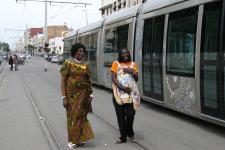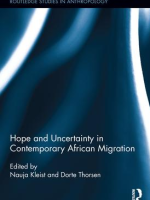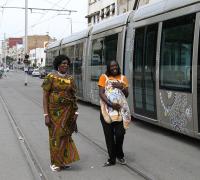Hope and uncertainty in contemporary African migration

The Covid-19 pandemic has introduced new restrictions on mobility and uncertainty about the future across the globe, but in unequal ways. Borders have closed, stricter exit and entry demands introduced, and people crossing borders might be quarantined with immediate effect. People who wish to travel follow news closely, with consideration of when and whether the situation may change to the better or the worse. And planning … well, planning involves a readiness to re-direct and re-consider one’s next move at short notice.
While the global pandemic is unparalleled in recent history, coping with mobility restrictions may be new for people in the global North but for most people in the world it is not an exception. For African migrants, such conditions are and have been a pertinent feature of life for years. In the edited volume Hope and Uncertainty in Contemporary African Migration (now in open access) we examine the repercussions of such uncertainty for the horizons of hope and possibility in situations characterized by precarity and deepening inequality.
Hope, mobilities and precarity
Mobility is an important pathway for realising a different and more dignified life in many African contexts, premised on the hope that other places offer opportunities that cannot be accessed locally. Collective ideas about what constitutes a good life worth aiming for epitomise social hope. Embedded in broader social horizons of worthy futures and practices of care, hope is more than individuals’ aspirations for escaping uncertainty or chasing resources. Institutions like the state, social networks, and families stipulate who can and should pursue such ideas, in which way and to what degree – and who should not. The conditions and distribution of hope – and the pursuit of certain hopes – are thus characterized by intersecting local and global inequalities.
Hope and Uncertainty in Contemporary African Migration was born out of vehement critiques of the misrepresentations and disregard of the effects of Eurocentric policy-making on African populations. Since long inequalities in the global political economy have given states in the global North the upper hand in setting the agenda for mobilities in terms of who can access legal intercontinental migration.
Borders have been externalised far beyond the global North, impacting on long-established mobility practices in Africa and elsewhere. Yet, at the same time, the imaginaries of the good life elsewhere have become consolidated worldwide, whether circulated and communicated through social or international media, social networks or traveling. This situation constitutes a mobility paradox that highlights the ambiguous role of hope in African migration today. While some precarity stems from lack of opportunities in the home context, much more is a fallout from the management of mobilities that continues to be ever more restrictive. How migrants navigate this paradox is the central question of the book.
Conceptualising hope
In Hope and Uncertainty in Contemporary African Migration, we conceptualise hope as a socially mediated capacity. We thus understand hope as situated, reiterating inequalities and diversities, but nevertheless representing a potential for betterment or sense of anticipation. Hope always carries the possibility of failure or delay, however, emphasizing that hope analysis is not equivalent to examining success or optimism.
The volume is organized in the following way: In the introduction, we set the stage and discuss hope theories and their analytical potential. The remaining part of the volume consists of nine ethnographically rich and theoretically informed case studies, set in migrants’ countries of origin, zones of transit, and in new and established destinations within and beyond the continent as well as in Europe, North and Latin America, and East Asia. Together they address three dimensions of hope.
Repositories of hope
What and where are the locations and sources of hope? Heike Drotbohm, Ida Marie Savio Vammen and Jesper Bjarnesen unpick how different types of information and knowledge feed social hope, such as faith, social networks and popular culture. Information disseminated by authorities and other stakeholders unconnected with the common experiences of (prospective) migrants is a less trusted source. Yet, the incoherence and uncertainty of intersecting migration regimes inspire the performance and brokering of hope.
Near and distant futures
When is the time of hope? A key feature of hope is its focus on the future, but the concept of future is inherently vague. It relates to different dimensions of temporality, relating to time, anticipation, waiting or postponement. Steven Lubkemann, Heidi Østbø Haugen and Maria Hernández-Carretero examine how hope can be transposed to other places, be celebrated in a not-yet form to safeguard the existence of hope or be carefully planned for when the time is right, even though such plans might be postponed repeatedly.
Immobility
Finally, what happens when migrant projects are delayed and stuck or are terminated prematurely? Sylvie Bredeloup, Hans Lucht and Nauja Kleist explore the social and existential ramifications of adventure and involuntary immobility. They analyse the moral experience among migrants seeking to maintain hope in extremely difficult circumstances characterized by social stigmatization and hopelessness, such as prolonged journeys and post-deportation life. These and other chapters thus accentuate the perseverance but also the ambivalence of hope.
About the book
Hope and Uncertainty in Contemporary African Migration has been praised in book reviews as providing ”invaluable insights”, ”a new conceptual framework”, ”a thought-provoking intervention” and ”highly recommended as a valuable approach for unpacking the complexity of contemporary migration."
The book is edited by Nauja Kleist and Dorte Thorsen as part of the ‘New Geographies of Hope and Despair’ collaborative research project, funded by DRCIR – Humanities. The volume was first published by Routledge in 2017, it can now be downloaded freely here.
Nauja Kleist is a Senior Researcher at Danish Institute for International Studies
Dorte Thorsen is a Research Fellow at the Institute for Development Studies, University of Sussex
DIIS Experts



